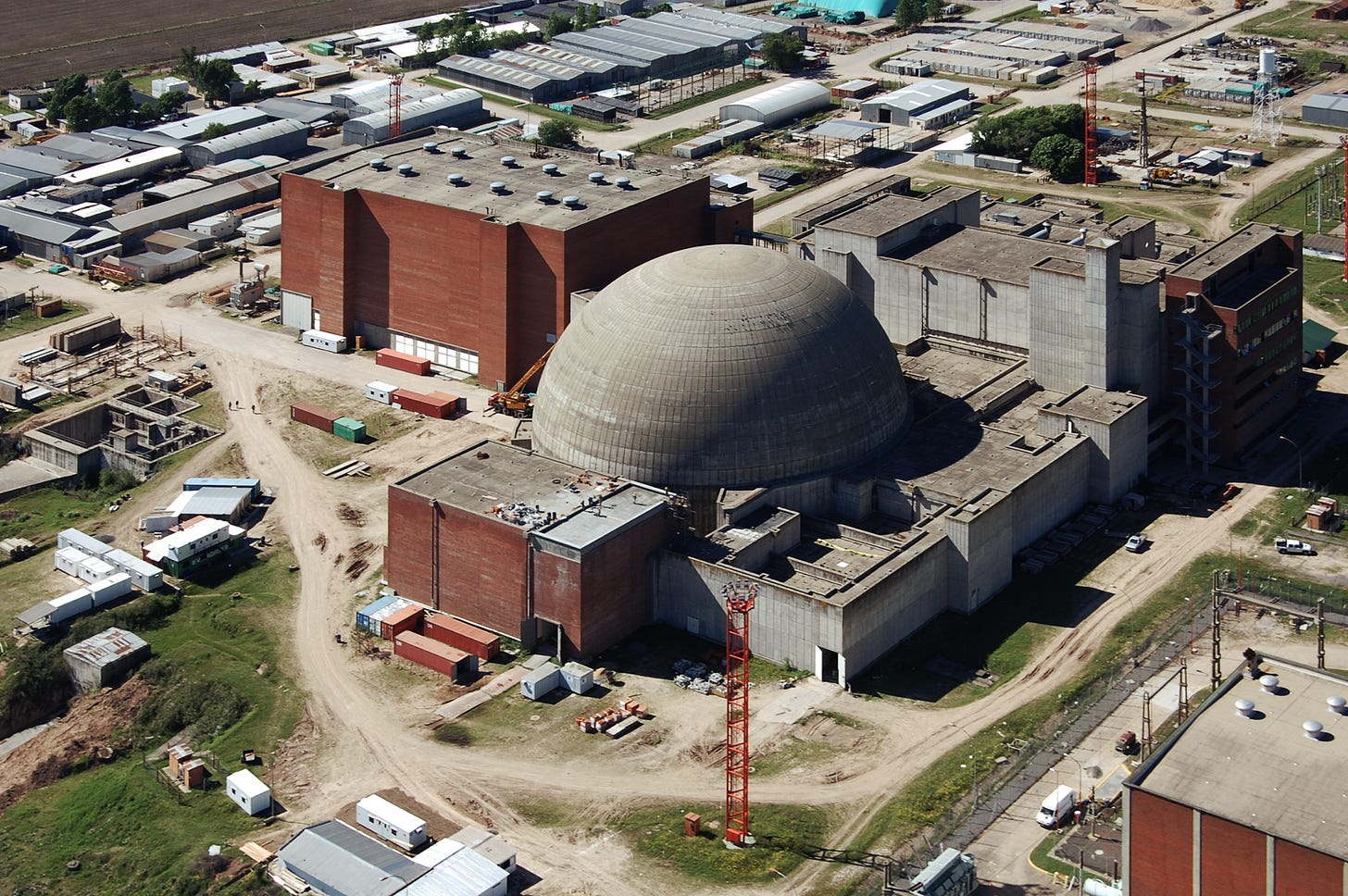Argentina’s Bailout and the New Digital Extractivism
The fusion of austerity and AI "innovation" turns crisis management into a frontier for U.S. power and corporate profit

The legacies of extractivism and crisis meet technology
Lithium extraction by foreign firms in Argentina is a visible emblem of global hierarchy: vast salt flats feeding distant battery supply chains while local communities see little return. The new digital extractivism is less visible in this way, but much more consequential—targeting policy and sovereignty as much as minerals. The same logic that probes the ground for lithium now probes the state for guarantees, revenue channels, and regulatory favors, aligning energy, data, and finance to reconstruct patterns of dependency through AI and the language of “innovation.”
Seen through that lens, the latest crisis reads differently. Argentina has recently dominated headlines as the peso slides, reserves turn sharply negative, and bond spreads flash default risk. In September 2025, Treasury Secretary Scott Bessen confirmed that Washington was preparing extraordinary support, a roughly $20 billion “bazooka” that included swap-style facilities and even potential U.S. purchases of Argentine sovereign bonds. Markets rallied on the signal, with bonds jumping more than 10% in a single session, underscoring how quickly this digital-extractive circuitry converts political commitments into financial gains.
Mainstream financial commentary framed this as nothing all that new. The Financial Times argued that “Argentina has a history of losing market credibility, and Milei’s government overplayed its hand by moving too quickly” while suggesting that U.S. backing could buy time until “real reforms” are completed in labor and tax policy. The Wall Street Journal warned that the public is “losing faith in Milei’s free-market revolution” and pressed for more decisive steps toward dollarization. From this vantage point, Argentina is a perennial reform laggard, and external support is a pragmatic stabilizer that gives investors breathing room.
Progressive and heterodox observers offer a different account. Analysts at the Peterson Institute warn that a U.S. rescue may invite new problems by deepening reliance on official creditors while leaving the dollar gap intact. Scholars of global debt politics add that bailouts function as disciplinary technologies that bind debtor states to austerity.1 Protesters in Buenos Aires echoed this view in mid-2024 with chants of “no al saqueo” as they opposed Milei’s reforms. Critics then extend the argument to the digital realm, where foreign AI investment in energy and data centers resembles older patterns of mineral and agricultural extraction. For them the core issue is not failed reform but a dependency in which creditor stability and (now) high-tech investment are prioritized over social welfare.
Within this debate Milei has sought to shift the terrain. He describes himself as carrying out “chainsaw economics,” promising to slash “the parasitic state” and deliver Argentina as “the freest country in the world.” His administration has paired sweeping decrees and omnibus reform bills with a futurist discourse of technological transformation. Milei insists that austerity today is the precondition for “turning Argentina into an intelligent power,” positioning the country as a future hub for artificial intelligence and data-driven industries.
The crisis is being managed not simply through austerity, but by selling a technological future. Promises of AI hubs and data-driven growth rebrand cuts and institutional rewiring as “modernization,” while channeling external finance into privatized energy, land, and compute infrastructure. In practice, the bailout de-risks these projects for foreign creditors, asset managers, and tech firms. Announcements like OpenAI’s serve as political cover for shifting risk and discipline onto the public, while profits and control accrue abroad. Read in Argentina’s longer trajectory, this is crisis management by external dependence wrapped in techno-optimist alibis.
Dependency structures Argentina’s turn towards authoritarian neoliberalism
Argentina has long lived under the weight of its external constraint. Postwar industrialization relied on tariffs and state intervention, but imported machinery and commodity-based exports kept the economy vulnerable to balance-of-payments pressure. That structural tension set the rhythm for recurring crises. The 1976 coup deepened this dependence by liberalizing trade and finance, and under Carlos Menem in the 1990s, privatization and a one-to-one peso-dollar peg brought short-term stability at the cost of hollowing out state capacity. When global credit conditions reversed after the dot-com bust (2000) and the post-9/11 (2001) slowdown, Argentina’s debt dynamics—already fragile under the convertibility regime—unraveled. The government’s attempt to placate investors through the megacanje, a large-scale debt swap promoted as a show of fiscal discipline to maintain IMF support, backfired. It increased long-term obligations and drained credibility. By December 2001, as capital flight accelerated and fiscal targets were missed, the IMF withheld its next disbursement. Within weeks, the peso peg collapsed, unleashing default, bank freezes, and the country’s worst economic crisis in modern history.
The Kirchner governments that followed (2003–2007, 2007–2015) sought to regain autonomy through debt renegotiation, IMF repayment, and state-led redistribution, briefly easing external pressure during the commodity boom. When prices fell, dependence re-emerged. Mauricio Macri (2015–2019) reversed course, reopening capital accounts and issuing massive foreign debt. The $57 billion IMF program that followed—its largest ever—promised credibility but delivered recession and renewed default risk, proving that re-entering global markets without structural reform only reproduces crisis.
Alberto Fernández’s administration (2019–2023) pursued a centrist stabilization amid pandemic shocks and inflation but drifted into paralysis. By 2023, deficits persisted, reserves were depleted, and investor confidence had evaporated. Into this vacuum stepped Javier Milei, channeling frustration through libertarian populism. On his first day, he issued Decree 70/2023, a 366-article “mega-decree” rewriting regulation across sectors and bypassing Congress. Soon after came the Ley de Bases, an omnibus bill enabling privatizations, loosening oversight, and granting long-term guarantees to large investors. Passed in mid-2024 after fractious negotiations, it formalized his shock program and placed the old architects of liberalization back at the helm of a new, more concentrated experiment in market rule.
Rather than treading an entirely new course, neoliberalism has returned with less scruples. Milei’s Minister of Deregulation and State Transformation, Federico Sturzenegger, helped design the failed megacanje in 2001. His return—alongside other veterans of Menem’s neoliberal experiment, including Guillermo Francos and Martín Menem—underscores how Milei’s so-called libertarian revolution revives the neoliberal playbook. The “chainsaw” rhetoric may be new, but the personnel and policy logic echo the 1990s: faith in markets, external borrowing as reform discipline, and dependence on global finance that once again risked ending in collapse.
This may be why Milei’s government has been able to move so fast. The budget was cut by nearly 30% within months, and deregulation proceeded at a dizzying pace—the libertarian/conservative outlet Cato Institute counted two rollbacks a day. The emerging order resembles authoritarian neoliberalism. Under crisis conditions, executive power concentrates, legislative debate narrows, and reforms advance before opposition can organize. Courts have challenged portions of the decree, especially labor provisions, and mass protests have erupted, yet much of the framework remains intact.
Politically, Milei faces a legitimacy problem. His movement lacks a solid majority in Congress and relies on a pragmatic, transactional fragment of Peronist support (peronismo dialoguista). To compensate, he speaks the language of techno-populism—promising innovation, digital modernization, and a new era of efficiency—to attract finance and tech constituencies while deflecting social unrest. His coalition rests uneasily between global investors and domestic sectors hurt by austerity, exposing the contradictions of a project that weds radical market reform to concentrated executive rule.
Digital extractivism is at the center of Milei’s economic experiment
It’s as absurd as it sounds, AI-driven growth is being positioned as a substitute for science—more precisely, artificial intelligence is being promoted as a replacement for genuine human knowledge-making. From the start of his presidency, Milei has described the dismantling of Argentina’s research institutions as the price of becoming a “global AI hub.” Cuts to the national science agencies—CONICET, INTA, and ARSAT—are framed as modernization. In reality, they have gutted public capacity. Researchers have seen their pay collapse, funding for labs has evaporated, and the country’s most talented scientists are taking side jobs or leaving. A new decree (447/2025) has centralized decision-making in a small, politically appointed board, narrowing research priorities to those that serve private innovation. The government’s message is clear: knowledge matters only when it attracts investors.
Milei uses the language of digital transformation to give austerity a futuristic gloss. In his telling, dismantling the old state makes room for the private sector to lead a high-tech renaissance. AI becomes both the symbol and the strategy. Technology will redeem hardship by attracting foreign investment, creating jobs, and putting Argentina on the map of global innovation. Yet, what he calls “efficiency” and “liberation” amounts to converting the public sphere into a platform for private capital.
The energy sector sits at the center of this vision. Milei argues that Argentina’s traditional grid cannot power the data-intensive future he imagines, so he has turned to nuclear energy and foreign finance. His government is promoting a new small modular reactor designed by Argentina’s Invap but funded largely by U.S. investors. To make the deal possible, the state has started privatizing its nuclear company, Nucleoeléctrica Argentina, selling 44% of its shares while calling it a “nuclear resurgence.” It’s a telling move. The push for AI is used to justify privatization, and privatization is sold as the key to powering AI. The loop between narrative and policy is pretty crude but complete. Yet the tension between ambition and implementation is stark. Despite the nuclear plan, the national atomic agency (CNEA) remains stuck at 2023 nominal budgets, inflation hollowing out its resources.

Nevertheless, Patagonia is cast as the territory of this new future. With its cool climate and open land, officials describe it as perfect for data centers that need vast energy and low cooling costs. To draw foreign firms, Milei’s government passed a sweeping law—the RIGI, or Régimen de Incentivo para Grandes Inversiones—which offers long-term tax breaks and foreign-exchange privileges to investors who spend more than $200 million. The plan is to turn Argentina into a hosting hub for global computation—a place that supplies the energy and the land while control of the data and profits would likely remain offshore.
This agenda took shape in October 2025 with the announcement of Stargate Argentina, a $25 billion project between OpenAI and Sur Energy to build a 500-megawatt data-center complex in Patagonia. The deal, negotiated under the RIGI framework, binds Argentina’s energy infrastructure to OpenAI’s computing empire. Press photos of Milei standing alongside OpenAI executives were presented as proof that Argentina had “entered the AI age.” But the timing of the announcement came just as the Trump administration confirmed its ~$40 billion bailout for Argentina, suggesting that financial rescue and technological partnership are part of the same strategy. The AI corridor provides the political and ideological cover for deeper external alignment.

For Milei, this alignment is the point. The AI narrative allows him to present deregulation and privatization as forward-looking rather than regressive. It signals to U.S. and global investors that Argentina is open for business on favorable terms, even as domestic science and public employment are dismantled. Patagonia becomes a new kind of frontier—not of national development, but of hosting capacity for global (U.S.) platforms. The government’s promise of an AI-driven renaissance is built on selling energy, territory, and regulatory freedom to outside capital. Yet, research institutions are collapsing, the state is shrinking, and those most qualified to lead this “innovation revolution” are leaving. But will this story work? Can it really turn a crisis into a generative narrative? Is the dream of technology salvation amid decline?
Financial rescue shifts risk to the public and power to Washington
Announced in the middle of a government shutdown in Washington, the ~$40 billion U.S.–Argentina package was framed as a vote of confidence in Javier Milei’s reform agenda. Half of the amount comes from direct Treasury and IMF support, and half from a private-sector facility designed to attract investment. Following the announcements, the peso stabilized, bond prices rose, and investors booked quick gains, but revealed how closely Argentina’s economy now moves to signals from Washington. The bailout functioned less as a domestic policy achievement than as a display of U.S. leverage, shifting risk from private investors to the public.
The IMF provides the institutional frame for this arrangement. Its four-year lending program, approved in April 2025, conditions every tranche on fiscal tightening, higher tariffs, and reserve accumulation. The stated goal is macroeconomic stability, but the effect is subordination. Policy is disciplined through compliance reviews that privilege debt repayment, currency defense, and investor confidence over social spending or productive investment. Dependency is re-enforced through the language of fiscal responsibility. Each round of external “support” narrows Argentina’s capacity to set priorities beyond the immediate demands of its creditors.
Behind the technical design lies a clear geopolitical intent. Secretary of the Treasury, Scott Bessent, described the operation as part of an “economic Monroe Doctrine,” a strategy to reassert U.S. influence in Latin America and counter Chinese lending. Trump himself made the political dimension explicit, publicly stating “If he loses, we are not going to be generous with Argentina.” The timing ensured that the injection of dollars would stabilize the peso and lift markets in the run-up to Argentina’s legislative elections, giving Milei a short-term political dividend while anchoring his government to U.S. oversight.
Financially, the beneficiaries are also familiar. The arrangement—roughly a $20 billion dollar-peso swap and a $20 billion private debt facility—creates opportunities for U.S. banks such as JPMorgan, Goldman Sachs, and Citi, and for asset managers like BlackRock, Fidelity, and PIMCO. Rising bond prices and reduced default risk deliver immediate windfalls to these firms, while the new facilities generate fees and collateralized positions tied to Argentine assets. Treasury gains strategic leverage, Milei gains temporary currency stability, and investors lock in upside with minimal exposure.
Over the longer term, the stabilization of Argentina’s financial environment opens the door for U.S. technology and energy interests as noted above. A steadier peso and easier access to dollars favor the build-out of AI-related infrastructure and lithium extraction projects promoted under the RIGI investment regime. As journalist Pablo Calvi observed, the bailout ultimately serves elites on both sides of the equator—banks, funds, and tech corporations—rather than the Argentine public. The package thus continues a historical cycle in which crises are managed through external dependence: short-term confidence for investors, structural vulnerability for everyone else.
Something to learn here?
Although differences abound, the echoes of the 2001 crisis and today’s bailout reveal the same underlying logic—financial stability is pursued by transferring risk from creditors to the public. Each round promises a reset and delivers deeper dependence. Argentina’s current crisis is not exceptional; it is the latest iteration of an enduring pattern in which the external constraint—vulnerability to capital flows and export shocks—triggers actions fiscal retrenchment, institutional restructuring, and political concentration. What distinguishes the present moment is the fusion of austerity with a technological imaginary that casts dismantling the state as the path to digital modernization—a thin cover story that claims a smaller state will unlock a shiny digital future.
The language of AI hubs, nuclear-powered data centers, and “intelligent power” reframes foreign intervention as partnership and turns fiscal discipline into evidence of investor confidence. The narrative satisfies multiple audiences. It reassures U.S. policymakers that Argentina is a strategic ally, signals to global capital that new frontiers of data and energy are open, and offers domestic cover for the contraction of public institutions. Yet beneath the rhetoric, research budgets collapse, scientific talent drains abroad, and inequality widens. The digital future effectively functions as spectacle—an alibi for policies that deepen, rather than escape, structural dependence.
This blend of finance and futurism is not only an Argentine phenomenon. From compute corridors in the United States to AI zones in Europe, tech promises now organize how crises are managed and how states are disciplined. Argentina shows this logic in a clear and concentrated way, where fiscal fragility, geopolitical ambition, and digital aspiration meet.
The links between U.S. finance during the dot-com bust and today’s AI boom in Argentina are telling. The landscape has changed, with AI industrial policy and a more complex global economy reshaping both the shape of crises and the tools used to manage them. To see how this will play out now, we have to look beyond balance sheets and focus on the stories that make these policies seem necessary. In today’s digital capitalism, technology serves not only as infrastructure but as a means of governing through the promise of innovation while perpetuating dependency and control.
References
Gill, Stephen. 1995. “Globalisation, Market Civilisation, and Disciplinary Neoliberalism.” Millennium Journal of International Studies 24 (3): 399–423. Also see: Kentikelenis, Alexander E., Thomas H. Stubbs, and Lawrence P. King. 2016. “IMF Conditionality and Development Policy Space, 1985–2014.” Review of International Political Economy 23 (4): 543–82.



https://open.substack.com/pub/thiagodearagao/p/five-things-the-us-wants-from-argentina?r=2di31u&utm_medium=ios